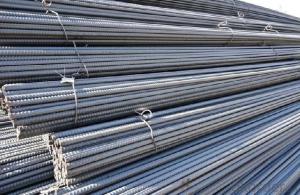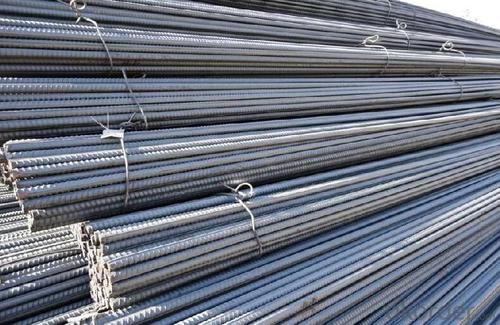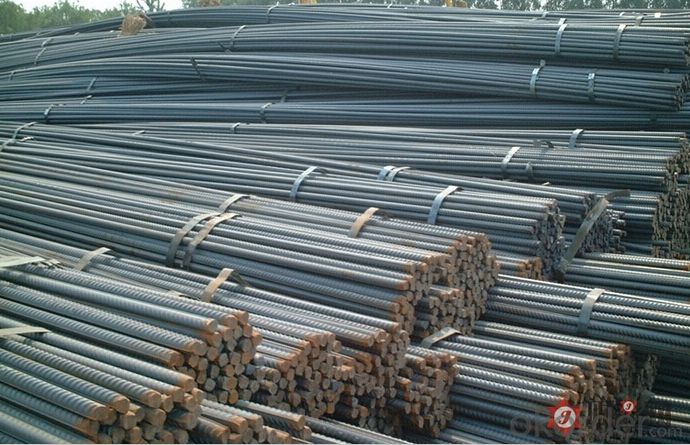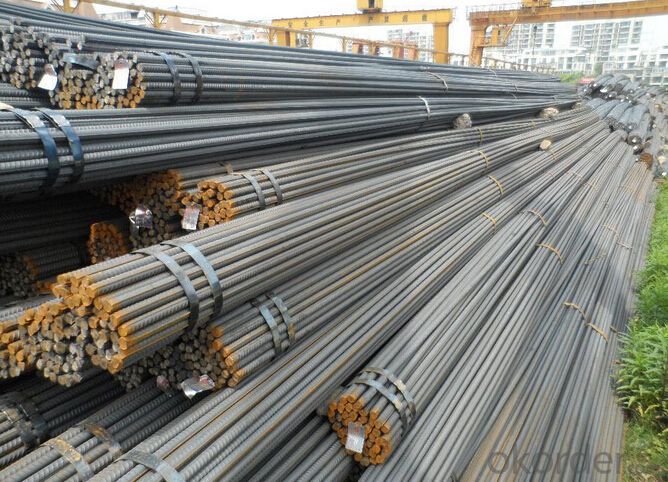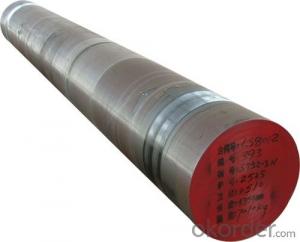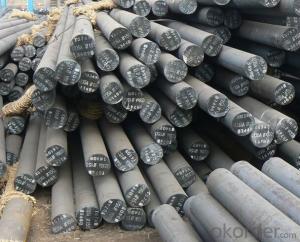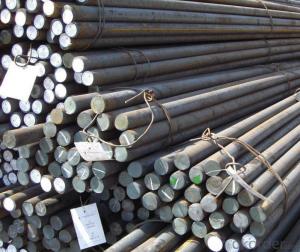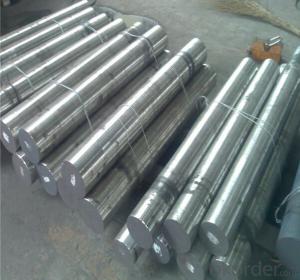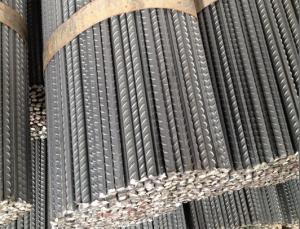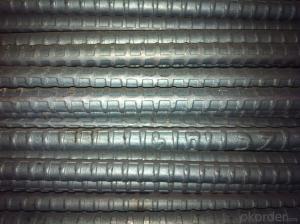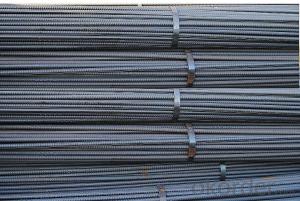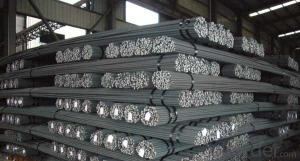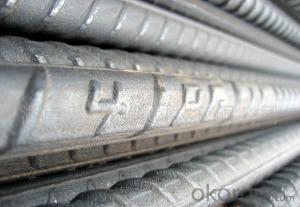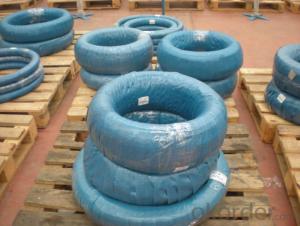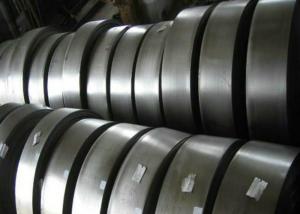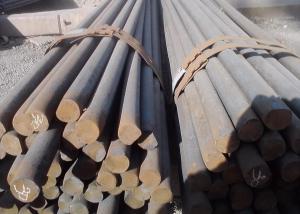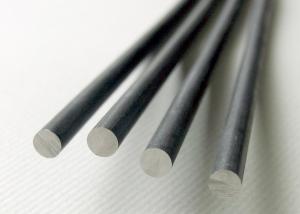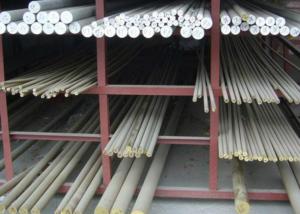ASTM A615 G60 8mm 10mm 12mm Deformed Steel Bar
- Loading Port:
- Qingdao
- Payment Terms:
- TT OR LC
- Min Order Qty:
- 5 m.t.
- Supply Capability:
- 100000 m.t./month
OKorder Service Pledge
Quality Product, Order Online Tracking, Timely Delivery
OKorder Financial Service
Credit Rating, Credit Services, Credit Purchasing
You Might Also Like
Specification
Type:
Carbon Steel,Spring Steel,Bearing Steel,Gear Steel,Deformed Steel,Stainless Steel,Alloy Steel
Shape:
Steel Coil,Steel Sheet,Steel Wire Rod,Steel Flat Bar,Steel Square Bar,Steel Angle,Steel Round Bar,Steel Billets
Technique:
Hot Rolled,Cold Rolled,Cold Drawn,ERW,Forged,Saw,Extruded,EFW,Spring
Surface Treatment:
Galvanized,Coated,Copper Coated,Color Coated,Oiled,Dry,Chromed Passivation,Polished,Bright,Black,PVDF Coated
Certification:
ISO,SGS,BV,IBR,RoHS,CE,API,BSI,UL
Thickness:
6mm-32mm
Width:
6mm-32mm
Length:
6-12m
Outer Diameter:
6mm-32mm
Net Weight:
100kg
Packaging:
seaworthy packaging
ASTM A615 G60 8mm 10mm 12mm Deformed Steel Bar
Detailed Information of ASTM A615 G60 8mm 10mm 12mm Deformed Steel Bar
| Name | Steel Round Bar |
| Shape | Round Bar/Square Bar/Flat Bar/Plate/Wire |
| Standard | GB/ASTM/SAE/AISI/DIN/JIS/EN/BS |
| Surface Treatment: | Black/Peeling/Polished/Machined |
| Delivery Condition: | Hot Rolled or Forged/Peeled or Black Surface |
| Test | SGS/UT 100% Elements Testing |
| Certificate: | ISO/Mill Certificate |
| Service: | 24 hours online service / |
| more than 20 years trading and manufacture | |
| Quality Assurance: | the third party inspection, such as SGS, BV, TUV…etc. is acceptable |
| Packaging Details: | Seaworthy Packaging or as per customer's packing instruction |
Product Overviews of ASTM A615 G60 8mm 10mm 12mm Deformed Steel Bar
| Product Name | Typical Grades | Diameter(mm) | Standard Adopted |
| Carbon Steel | 20 (1020/S20C/C22) | ||
| 40 (1040/S40C/C40) | Ø16-Ø300 | ||
| 45 (1045/S45C/C45) | |||
| Bearing Steel | GCr9 (51100/SUJ1) | ||
| GCr15 (52100/SUJ2/100Gr6) | Ø12-Ø250 | ||
| GCr9SiMn (A485-Gr.1/SUJ3) | GB/SAE/ | ||
| Cr-Mo Steel | 20Cr (5120/SCr420H/20Cr4) | JIS/DIN | |
| 40Cr (5140/SCr440/41Cr4) | Ø12-Ø250 | ||
| 42CrMo(4140/SCM440/42CrMo4) | |||
| Gear Steel | 20CrNiMo | ||
| 20CrMn(5115/SMnC420/20MnCr5) | Ø16-Ø600 | ||
| 20CrNiMo(8620/SNCM220/20CrMiMo2) |
Company Introduction of ASTM A615 G60 8mm 10mm 12mm Deformed Steel Bar
CNBM International Corporation is the most import and export platform of CNBM group(China National Building Material Group Corporation) ,which is a state-owned enterprise, ranked in 270th of Fortune Global 500 in 2015.
With its advantages, CNBM International are mainly concentrate on Cement, Glass, Iron and Steel, Ceramics industries and devotes herself for supplying high quality series of refractories as well as technical consultancies and logistics solution.
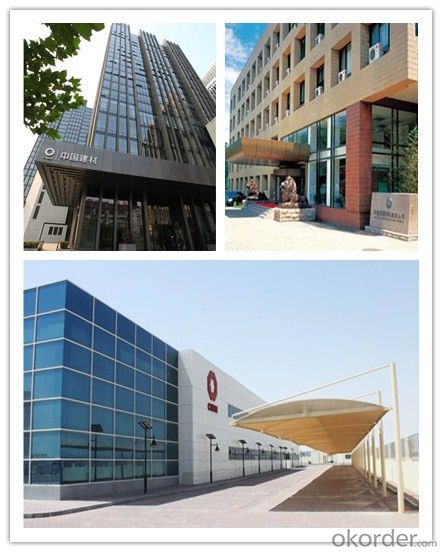
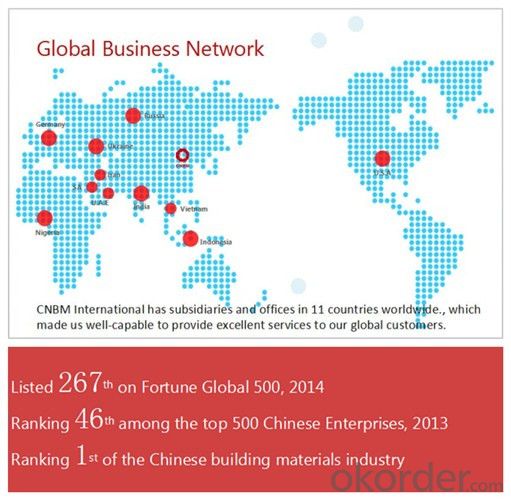
| After-sale service | l CNBM provides the services and support you need for every step of our cooperation. We’re the business partners you can trust; you can relax and get on with doing business. |
| l For any problem, please kindly contact us at any your convenient time, we’ll reply you in our first priority within 24 hours | |
| Advantages | l Industry experience over 20 years. |
| l Shipment of goods -More than 70 countries worldwide. | |
| l The most convenient transport and prompt delivery. | |
| l Competitive price with best service. | |
| l High technical production line with top quality products. | |
| l High reputation based on best quality products. | |
Packaging & Delivery of ASTM A615 G60 8mm 10mm 12mm Deformed Steel Bar
| Packaging Detail | Sea worthy packing /as per customer's packing instruction |
| Delivery Detail | 15 ~ 40 days after receiving the deposit |
Products Show
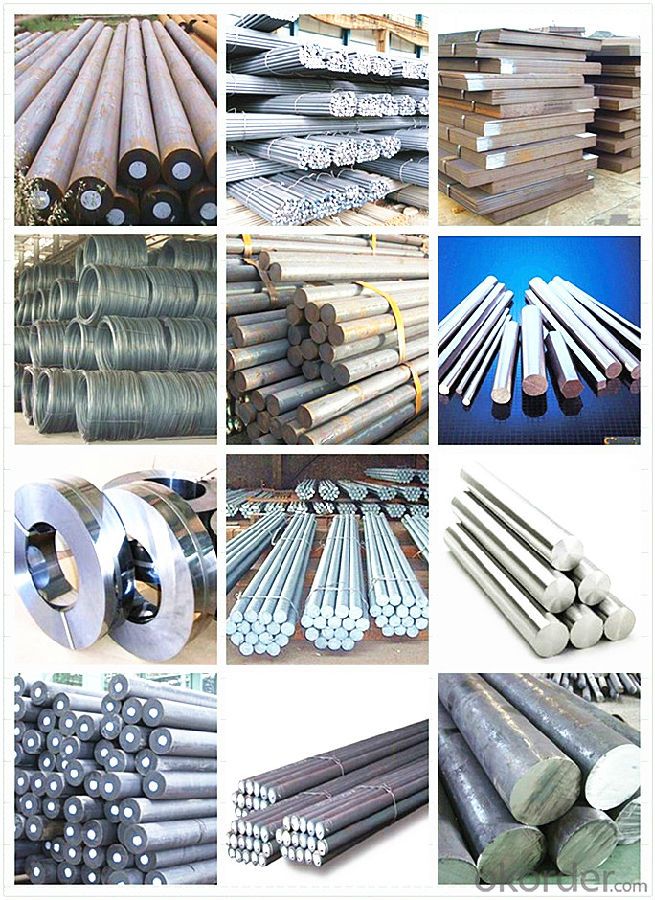
FAQ:
| Are you a trading company or manufacturer? | Manufacturer |
| What’s the MOQ? | 1000m2 |
| What’s your delivery time? | 15-20 days after downpayment received |
| Do you Accept OEM service? | Yes |
| what’s your delivery terms? | FOB/CFR/CIF |
| What's the Payment Terms? | 30% as deposit,70% before shipment by T/T |
| Western Union acceptable for small amount. | |
| L/C acceptable for large amount. | |
| Scrow ,Paybal,Alipay are also ok | |
| Why choose us? | Chose happens because of quality, then price, We can give you both. Additionally, we can also offer professional products inquiry, products knowledge train (for agents), smooth goods delivery, excellent customer solution proposals. |
| What's your available port of Shipment? | Main Port, China |
| What’s your featured services? | Our service formula: good quality+ good price+ good service=customer's trust |
| Where are your Market? | Covering more than 160 countries in the world |
- Q: How is high-temperature stainless steel used in the production of gas turbines?
- High-temperature stainless steel is used in the production of gas turbines due to its exceptional heat resistance and corrosion resistance properties. It is utilized to make critical components such as turbine blades, rotors, and casings that are exposed to extreme temperatures and harsh environments. This stainless steel helps gas turbines operate efficiently and reliably by withstanding high temperatures without losing strength or degrading, ultimately enhancing the performance and lifespan of gas turbines.
- Q: Can special steel be used in the power transmission industry?
- Yes, special steel can be used in the power transmission industry. Special steel alloys offer enhanced strength, durability, and resistance to wear and corrosion, making them suitable for various components in power transmission equipment such as gears, shafts, bearings, and connectors. These alloys can withstand high loads, extreme temperatures, and harsh environmental conditions, ensuring reliable performance and longevity in power transmission applications.
- Q: What are the challenges in forming special steel?
- Forming special steel poses several challenges due to its unique characteristics and properties. Some of the main challenges include: 1. High melting point: Special steels often have high melting points, which require specialized equipment and processes to heat and form the material. This can lead to increased energy consumption and cost. 2. Alloy composition: Special steels are typically alloyed with various elements to enhance their properties, such as strength, hardness, and corrosion resistance. However, the precise control of alloy composition can be challenging, as minor variations can significantly affect the material's properties. 3. High carbon content: Certain special steels, such as tool steels, contain high carbon content to enhance hardness and wear resistance. However, this high carbon content makes the material more prone to cracking during forming processes like forging or rolling. Special care must be taken to prevent these cracks and ensure the desired shape is achieved. 4. Heat treatment requirements: Special steels often require specific heat treatment processes, such as quenching and tempering, to achieve the desired mechanical properties. These processes can be complex and require precise control of temperature, time, and cooling rates. Failure to properly carry out heat treatment can result in poor material performance or even structural failure. 5. Surface finish and dimensional accuracy: Special steels are often used in applications where surface finish and dimensional accuracy are critical, such as in the aerospace or automotive industry. Achieving the required surface finish and dimensional accuracy during forming operations can be challenging, requiring advanced tooling and precision machining techniques. 6. Specialized equipment and expertise: Special steels may require specialized equipment and expertise to form, such as high-pressure hydraulic presses, induction heating equipment, or vacuum furnaces. These specialized tools and processes add complexities and costs to the manufacturing process. Despite these challenges, forming special steels is essential in various industries where their unique properties are required. Manufacturers continuously invest in research and development to overcome these challenges and improve the forming processes of special steels.
- Q: How does special steel contribute to the textile industry?
- Special steel contributes to the textile industry by providing high-strength and durable components for textile machinery, such as looms, knitting machines, and textile processing equipment. The use of special steel in these machines ensures improved performance, precision, and longevity, thereby enhancing productivity and efficiency in textile manufacturing processes. Additionally, special steel's resistance to corrosion and wear helps maintain the quality and reliability of textile machinery, minimizing downtime and maintenance costs for manufacturers.
- Q: How does special steel perform under extreme cold conditions?
- Special steel is specifically engineered for optimal performance in frigid conditions. It demonstrates exceptional resistance to low temperatures and retains its strength and toughness even in freezing conditions. This is accomplished by incorporating alloying elements, such as nickel, chromium, and molybdenum, which enhance the steel's ability to remain pliable and resist brittle fractures. In frigid temperatures, regular steel tends to become brittle and prone to easy fracturing. However, special steel showcases remarkable toughness and resilience. It can endure extremely low temperatures while preserving its mechanical properties, rendering it suitable for various applications in cold settings. Furthermore, special steel boasts excellent corrosion resistance, a critical attribute when exposed to extreme cold environments. Cold environments can expedite corrosion due to factors like moisture, salt, and freezing and thawing cycles. Nevertheless, the corrosion-resistant nature of special steel prevents deterioration and upholds its structural integrity. Moreover, special steel possesses exceptional thermal conductivity, facilitating efficient heat transfer even in exceedingly low temperatures. This characteristic proves essential in applications where heat transfer plays a vital role, such as cryogenic systems or cold storage facilities. All in all, special steel's outstanding performance in extreme cold conditions positions it as an ideal material for a multitude of industries and applications, including aerospace, oil and gas, automotive, and construction. Its capacity to maintain strength, toughness, corrosion resistance, and thermal conductivity at low temperatures ensures reliable and secure operation in severe cold environments.
- Q: What are the different types of heat-resistant steel?
- There are various types of heat-resistant steel, including austenitic stainless steels, martensitic stainless steels, ferritic stainless steels, and precipitation hardening stainless steels. Additionally, nickel-based alloys such as Inconel and Hastelloy, as well as refractory metals like tungsten and molybdenum, are also considered heat-resistant steel materials.
- Q: How does special steel contribute to the fatigue resistance of products?
- Special steel contributes to the fatigue resistance of products by providing enhanced strength, durability, and resistance to wear and tear. The unique composition and manufacturing processes of special steel result in improved mechanical properties, such as higher tensile strength and hardness, which help products withstand repeated loading and stress cycles without failure. Additionally, special steel can be engineered to have specific microstructures that enhance its resistance to fatigue, preventing the growth of cracks and ensuring longer product lifespan.
- Q: What are the different methods of preventing galvanic corrosion in special steel?
- There are several methods available to prevent galvanic corrosion in special steel: 1. Coating: Applying a protective coating to the surface of the steel can prevent direct contact between the steel and the corrosive environment. This can be done using various types of coatings such as paints, epoxy, or polyurethane. The coating acts as a barrier and prevents the formation of galvanic cells. 2. Cathodic protection: This method involves making the steel the cathode in a galvanic cell, which prevents corrosion. This can be achieved through two techniques: sacrificial anode cathodic protection and impressed current cathodic protection. Sacrificial anode cathodic protection involves connecting a more reactive metal, such as zinc or magnesium, to the steel. The sacrificial anode corrodes instead of the steel, protecting it. Impressed current cathodic protection involves applying a low-level direct current to the steel, which prevents the formation of galvanic cells. 3. Isolation: By physically separating the special steel from other metals that are more reactive, galvanic corrosion can be prevented. This can be done by using insulating materials, such as plastic or rubber, between the steel and other metals. 4. Alloying: The addition of certain alloying elements to the special steel can improve its resistance to galvanic corrosion. For example, adding chromium to steel forms a passive oxide layer on the surface, which acts as a barrier against corrosion. 5. Design considerations: Proper design and engineering can also help prevent galvanic corrosion. For example, avoiding the use of dissimilar metals in close proximity can minimize the potential for galvanic corrosion. Additionally, designing structures to allow for proper drainage and ventilation can prevent the accumulation of moisture, which can accelerate galvanic corrosion. It is important to note that the selection of the most appropriate method for preventing galvanic corrosion in special steel depends on various factors such as the specific environment, cost considerations, and the desired lifespan of the steel.
- Q: How does special steel contribute to improving product sustainability?
- Special steel contributes to improving product sustainability through various ways. Firstly, special steel is known for its durability and strength, allowing products made from it to have a longer lifespan and reduced need for frequent replacements. This, in turn, reduces the overall waste generated from the manufacturing and disposal of products. Additionally, special steel is often used in the production of more energy-efficient products. For example, it is commonly used in the construction of wind turbines, which generate renewable energy. By using special steel in these applications, the efficiency and longevity of these products are enhanced, leading to a more sustainable energy generation system. Furthermore, special steel is often recyclable, meaning it can be melted down and reused in the production of new products. This helps to reduce the reliance on raw materials and minimizes the environmental impact associated with mining and extraction processes. Overall, the utilization of special steel in various industries contributes to improving product sustainability by promoting durability, energy efficiency, and recyclability.
- Q: How is HSLA steel used in the construction industry?
- HSLA steel, or High-Strength Low-Alloy steel, is widely used in the construction industry due to its superior strength and durability. It is commonly utilized in the construction of bridges, buildings, and other infrastructure projects. HSLA steel's high tensile strength allows for the creation of lighter and more efficient structures, reducing material costs and environmental impact. Additionally, its resistance to corrosion and atmospheric conditions makes it suitable for outdoor applications, ensuring the longevity of the constructed assets.
Send your message to us
ASTM A615 G60 8mm 10mm 12mm Deformed Steel Bar
- Loading Port:
- Qingdao
- Payment Terms:
- TT OR LC
- Min Order Qty:
- 5 m.t.
- Supply Capability:
- 100000 m.t./month
OKorder Service Pledge
Quality Product, Order Online Tracking, Timely Delivery
OKorder Financial Service
Credit Rating, Credit Services, Credit Purchasing
Similar products
Hot products
Hot Searches
Related keywords
